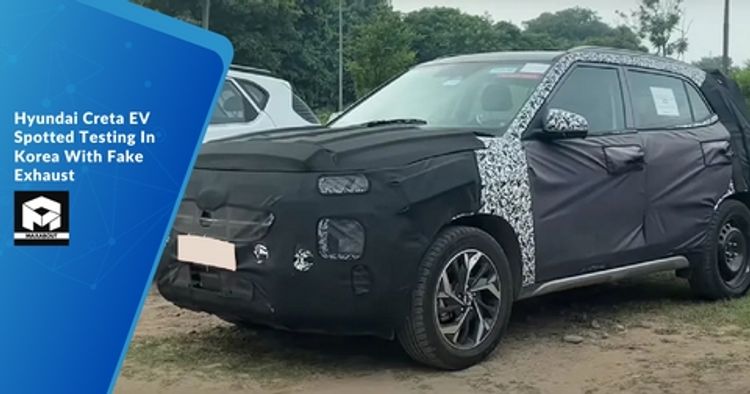A facelift for the Hyundai Creta, India's preferred small SUV, is planned, with the goal of creating a more attractive look that complements Hyundai's taste for striking and unique designs. The car industry is getting more and more crowded with competitors, but the Creta is expected to maintain its unique position. The Hyundai Creta EV is seen testing in recent spy photos from South Korea, which show off not just the design's development but also the calculated steps Hyundai is taking to maintain its place in the very competitive small SUV market. Come along as we explore the intricacies exposed by these spy photos, providing an overview of the expected enhancements and changes that will characterise the new Hyundai Creta EV.
Features
1.Method of Strategic Design
With nine rivals in the competitive compact SUV market, Hyundai plans to strengthen its unique design strategy in an effort to differentiate the Creta.
2. Emphasis on Front and Back Design
It is expected that the Hyundai Creta's facelift will result in significant visual changes, especially to the front and back, in line with current worldwide design trends for Hyundai vehicles.
3. Consistency of Profile
Although the outline of the incoming Creta EV is similar to that of earlier models, spy photos from South Korea suggest that the front fascia may be slightly different.
4. Improved LED daytime running lights
Upon closer examination, the spy photos show a different LED DRL arrangement: instead of the standard two LED DRLs, there are four LED DRLs. There are speculations about a special front fascia on the Creta EV. When Hyundai is ready to unveil the new Creta, fans can expect a mix of innovation and familiarity that will cause a stir in the small SUV market.
Fascia Conundrum
Although it is likely that the fascias of the Creta EV and ICE models are similar, more recent spy photos show a slightly different camouflage, revealing a more open design with quad LED components. The rear and front lights' Tetris-shaped LED arrangement captures interest in the development of Hyundai's iconic design.
Design Aspects and Camouflage Methods
One commonality between the ICE and Creta EV facelifts may be the split headlight design with vertically oriented headlights. But the degree of intricacy in the camouflage introduces a degree of doubt, particularly with respect to the unclear spy shot. In spite of this difficulty, the inclusion of a front camera, an ADAS suite radar module, and 360-degree viewing capabilities point to a strong emphasis on modern technology.
Interior Innovations
Peering inside the prototype, one can see that the dashboard has been altered to make room for a free-standing infotainment screen that is similar to that found in other Hyundai vehicles and the Seltos facelift. The redesign of the inside shows a dedication to modern design and intuitive user interfaces.
Powertrain Exploration
To get to the bottom of things, the test mule's fake exhaust indicates a simulated combustion system is being tested, but in actuality, it is testing an electric powertrain. This reflects Hyundai's progress toward an electric future and is in line with industry trends. These spy photos provide insight into Hyundai's ongoing dedication to innovation, as the distinctions between the ICE and electric versions of the Creta become more hazy. The brand skillfully combines design progress, state-of-the-art technology, and an innovative powertrain plan.
With a coming Creta EV facelift, Hyundai's classic Creta is set for a dramatic change as the automotive landscape continues its highly explosive evolution. This electric version, which will likely transform the small SUV market, represents a step toward a high-performance and sustainable future rather than just a cosmetic improvement.
Energising Performance
Hyundai's dedication to sustainable travel is demonstrated by the powerful 60 kWh battery that powers the Creta EV, which has a stated range of 500 km. The thrilling performance is anticipated to equal its internal internal combustion equivalent, the 1.5L turbo petrol Creta with 158 horsepower and 253 Nm torque, with a sub-10 second 0-100 km/h race.
Competition on the Horizon
The Citroen C3 Aircross EV, Tata Curvy EV, Honda Elevate EV, and other strong competitors are preparing to take on the Creta EV in the electrified market. The stage is set for an intense battle in the small SUV market as Hyundai aims to match and exceed the standards set by competitors.
Launch Anticipation
Although the launch of the Creta EV is much awaited, fans may have to wait until the end of 2024 or even 2025 to see the vehicle in person. Hyundai's meticulous attention to detail in creating an electric masterpiece suggests that the Creta EV is going to exceed expectations and bring in a new age of green transportation.
The automotive world anticipates a harmonious fusion of performance, range, and design as the countdown to the Hyundai Creta EV begins. This creative symphony has the potential to completely change the way that small SUVs are made in the future. Keep checking back for further details on Hyundai's electric journey.

